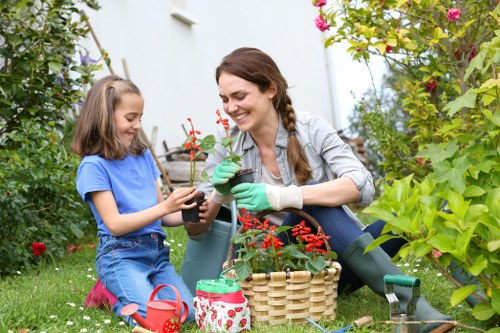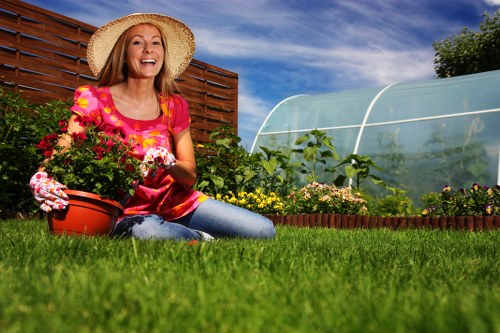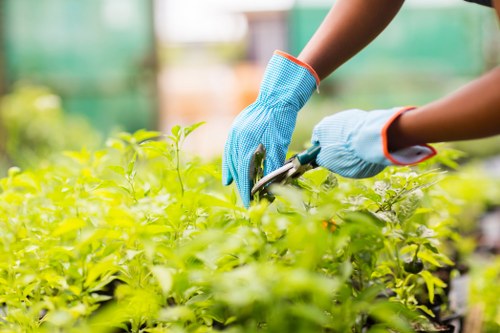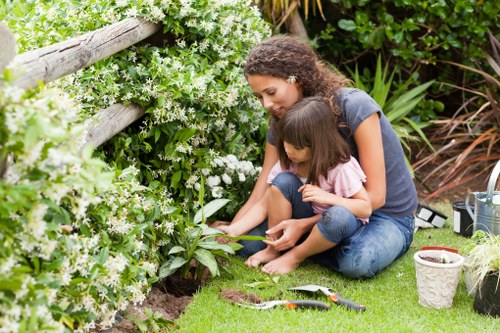Comprehensive Guide to Garden Maintenance in Victoria
Introduction to Garden Maintenance

Maintaining a beautiful garden in Victoria requires a blend of dedication, knowledge, and the right techniques. Whether you're a seasoned gardener or a novice, understanding the unique climate and soil conditions of Victoria is crucial for successful garden upkeep.
Victoria's diverse climate, ranging from cool temperate in the higher regions to a warmer Mediterranean climate along the coast, impacts the types of plants that thrive. Effective garden maintenance involves selecting the right plants, regular care, and adapting to seasonal changes.
By prioritizing garden maintenance, you not only enhance the aesthetic appeal of your outdoor space but also contribute to the overall health of your local ecosystem. This guide will walk you through the essential aspects of garden maintenance tailored specifically for Victoria's environment.
Understanding Victoria’s Climate

Victoria enjoys a varied climate that significantly influences garden maintenance practices. The state experiences four distinct seasons, each bringing its own set of challenges and opportunities for gardeners.
Spring is a time of renewal, with mild temperatures and increased rainfall. It's ideal for planting new shrubs and perennials. However, gardeners must be vigilant against pests that emerge during this period.
Summer brings warmer temperatures and longer days, perfect for growing vegetables and sun-loving plants. Regular watering and mulching are essential to retain moisture and protect plants from heat stress.
Essential Garden Maintenance Tasks

Effective garden maintenance involves a series of tasks that ensure the health and beauty of your garden year-round. Here are the key maintenance activities you should prioritize:
- Lawn Care: Regular mowing, watering, and fertilizing keep your lawn lush and green.
- Pruning and Trimming: Removing dead or overgrown branches promotes healthy plant growth and prevents disease.
- Weeding: Consistent weeding prevents invasive species from taking over and competing with your plants.
- Pest Control: Identifying and managing pests early prevents significant damage to your garden.
- Soil Management: Testing and amending the soil ensures that plants receive the necessary nutrients.
Seasonal Garden Maintenance

Adapting your garden maintenance routine to the changing seasons is vital for sustained garden health.
Spring Maintenance
In spring, focus on preparing your garden for the growing season. This includes:
- Clearing debris and dead plants.
- Applying a balanced fertilizer to enrich the soil.
- Planting new flowers, shrubs, and vegetables.
Summer Maintenance
Summer requires diligent care to cope with heat and dryness:
- Regular watering, preferably in the early morning or late evening.
- Mulching to retain soil moisture and suppress weeds.
- Monitoring for pests and diseases.
Autumn Maintenance
Autumn is ideal for preparing your garden for the winter months:
- Pruning trees and shrubs.
- Planting autumn flowers.
- Improving soil quality by adding compost or manure.
Winter Maintenance
During winter, focus on protecting your garden from cold weather:
- Covering delicate plants with frost cloths.
- Clearing fallen leaves and debris.
- Planning for next year’s garden layout.
Choosing the Right Plants for Victoria

Selecting plants that are well-suited to Victoria’s climate is fundamental for a thriving garden. Consider the following factors when choosing plants:
- Climate Compatibility: Opt for plants that can withstand Victoria’s temperature ranges and rainfall patterns.
- Soil Type: Test your soil to determine its pH and nutrient levels, then choose plants that thrive in those conditions.
- Sunlight Exposure: Ensure that plants receive the appropriate amount of sunlight, whether full sun, partial shade, or full shade.
- Water Requirements: Select plants with similar watering needs to make irrigation more manageable.
Popular Plants for Victorian Gardens
Here are some plants that flourish in Victoria’s gardens:
- Lavender: Thrives in full sun and well-drained soil.
- Roses: Require regular pruning and feeding to maintain health.
- Ferns: Prefer shaded areas with consistent moisture.
- Native Grasses: Low maintenance and ideal for creating naturalized areas.
- Ornamental Trees: Provide structure and shade to your garden landscape.
Soil Management and Fertilization
Healthy soil is the foundation of a vibrant garden. Implementing proper soil management techniques ensures that your plants receive the necessary nutrients for growth.
Soil Testing
Conducting regular soil tests helps you understand the composition and fertility of your garden soil. This information guides you in making informed decisions about amendments and fertilizers.
Amending Soil
Based on soil test results, you may need to amend your soil with organic matter such as compost, manure, or peat moss to improve its structure and nutrient content.
Fertilization
Applying the right type and amount of fertilizer ensures that your plants receive adequate nutrients without over-fertilizing, which can lead to plant stress and environmental issues.
Types of Fertilizers
- Organic Fertilizers: Derived from natural sources, they improve soil structure and provide slow-release nutrients.
- Inorganic Fertilizers: Provide immediate nutrients but do not improve soil structure.
Application Tips
Always follow the manufacturer’s instructions for fertilizer application and consider the specific needs of your plants to prevent nutrient imbalances.
Lawn Care in Victoria
A well-maintained lawn enhances the overall appearance of your garden and provides a lush, green space for relaxation and recreation.
Mowing
Regular mowing keeps your lawn healthy by encouraging dense growth and preventing weeds. Aim to mow your lawn to a height of 2.5 to 3 inches, adjusting based on the grass type.
Watering
Proper watering is essential for lawn vitality. Deep, infrequent watering encourages deep root growth, making your lawn more resilient to drought conditions.
Fertilizing
Fertilize your lawn during the growing seasons to provide essential nutrients. Choose a fertilizer suited to your grass type and follow recommended application rates.
Common Lawn Problems
- Weed Infestations: Prevent weeds by maintaining a healthy lawn through proper mowing, watering, and fertilization.
- Pest Damage: Identify and manage pests early to prevent significant damage.
- Diseases: Monitor for signs of lawn diseases and take appropriate measures to control them.
Pruning and Trimming
Pruning and trimming are essential for maintaining the shape and health of your plants and trees.
When to Prune
The best time to prune most plants is during the late winter or early spring before new growth begins. However, some plants may require summer pruning to remove dead or damaged branches.
Pruning Techniques
Use sharp, clean tools to make precise cuts. Remove any diseased, dead, or crossing branches to improve air circulation and sunlight penetration.
Tools of the Trade
- Hand Pruners: Ideal for small branches and detailed work.
- Pruning Saws: Suitable for larger branches.
- Loppers: Best for medium-sized branches.
Safety Tips
- Always wear protective gear, including gloves and safety glasses.
- Ensure your tools are sharp and in good condition to make clean cuts.
- Be cautious when pruning tall trees, and consider hiring a professional for large jobs.
Pest and Disease Management
Effective pest and disease management is critical to maintaining a healthy garden. Early detection and appropriate control measures can prevent minor issues from becoming major problems.
Identifying Common Pests
Common garden pests in Victoria include:
- Aphids: Small insects that suck sap from plants, causing wilting and stunted growth.
- Snails and Slugs: Feed on leaves and stems, leaving behind holes and slime trails.
- Caterpillars: Larvae that chew on foliage, often defoliating plants.
Natural Pest Control Methods
Consider environmentally friendly pest control options such as:
- Beneficial Insects: Introduce ladybugs and lacewings to control aphid populations.
- Neem Oil: A natural pesticide effective against a variety of pests.
- Handpicking: Manually remove pests like snails and caterpillars from your plants.
Managing Plant Diseases
Common plant diseases in Victoria gardens include:
- Powdery Mildew: A fungal disease that causes white powdery spots on leaves and stems.
- Root Rot: Caused by overwatering, leading to decayed roots and plant decline.
- Bacterial Wilt: Results in wilting and yellowing of leaves, often fatal to the plant.
Preventative Measures
- Ensure proper spacing between plants to enhance air circulation.
- Water plants at the base to keep foliage dry.
- Rotate crops annually to prevent soil-borne diseases.
Mulching and Weed Control
Mulching and weed control are essential practices for maintaining garden health and aesthetics.
The Benefits of Mulching
Mulching offers several advantages:
- Moisture Retention: Helps retain soil moisture during dry periods.
- Weed Suppression: Reduces the growth of unwanted weeds.
- Soil Temperature Regulation: Keeps the soil cool in summer and warm in winter.
- Soil Improvement: Organic mulches break down over time, enriching the soil.
Types of Mulch
- Organic Mulch: Includes wood chips, straw, and compost, which improve soil quality.
- Inorganic Mulch: Such as gravel or rubber, which do not decompose but are effective for weed control.
Effective Weed Control Strategies
Implement the following strategies to manage weeds effectively:
- Manual Weeding: Regularly remove weeds by hand to prevent them from establishing.
- Mulching: Apply a thick layer of mulch to block weed growth.
- Using Weed Barriers: Install landscape fabric to prevent weeds while allowing water and air to reach the soil.
Preventing Future Weeds
- Maintain a healthy garden to outcompete weeds.
- Regularly inspect and remove any new weed growth.
- Avoid over-fertilizing, which can encourage weed proliferation.
Watering Techniques
Proper watering is fundamental to garden maintenance. It ensures that plants receive the necessary hydration without wasting water.
Best Practices for Watering
- Deep Watering: Water deeply but infrequently to encourage deep root growth.
- Early Morning Irrigation: Watering in the early morning reduces evaporation and allows plants to absorb moisture before the heat of the day.
- Drip Irrigation: An efficient watering system that delivers water directly to the plant roots, minimizing waste.
Water Conservation Tips
- Use rainwater harvesting systems to collect and utilize natural rainfall.
- Implement mulch to reduce soil evaporation and retain moisture.
- Choose drought-tolerant plants that require less water.
Signs of Overwatering and Underwatering
- Overwatering: Yellowing leaves, root rot, and fungal growth.
- Underwatering: Wilting, dry soil, and stunted plant growth.
Integrated Pest Management (IPM)
Integrated Pest Management (IPM) is a sustainable approach to managing pests by combining biological, cultural, physical, and chemical tools.
Principles of IPM
- Prevention: Prevent pest problems through proper garden practices.
- Monitoring: Regularly inspect plants for signs of pests and diseases.
- Identification: Correctly identify pests to implement appropriate control measures.
- Control: Use a combination of methods to manage pest populations effectively.
Benefits of IPM
Implementing IPM offers several benefits:
- Reduces reliance on chemical pesticides, promoting a healthier environment.
- Minimizes pest resistance by using multiple control strategies.
- Enhances plant health and biodiversity in your garden.
Implementing IPM in Your Garden
- Start with preventive measures like selecting resistant plant varieties.
- Encourage beneficial insects that prey on pests.
- Use physical barriers such as nets or collars to protect plants.
- Apply targeted treatments only when necessary.
Sustainable Gardening Practices
Adopting sustainable gardening practices not only benefits your garden but also contributes to environmental conservation.
Composting
Composting recycles organic waste into nutrient-rich soil amendments, reducing the need for chemical fertilizers.
Rainwater Harvesting
Collecting and utilizing rainwater helps conserve water resources and provides plants with natural, chemical-free hydration.
Native Plant Selection
Choosing native plants supports local wildlife, requires less maintenance, and adapts better to Victoria's climate.
Benefits of Sustainable Gardening
- Reduces environmental impact by minimizing waste and conserving resources.
- Promotes biodiversity and supports local ecosystems.
- Creates a resilient garden that can withstand pests and climate variations.
Using Technology in Garden Maintenance
Modern technology offers various tools and solutions to streamline garden maintenance and enhance efficiency.
Smart Irrigation Systems
Automated irrigation systems can be programmed to deliver precise amounts of water, optimizing usage and ensuring plants receive consistent hydration.
Garden Management Apps
Apps provide scheduling tools, plant care reminders, and resources for identifying pests and diseases, making garden management more organized.
Soil Moisture Sensors
These sensors monitor soil moisture levels in real-time, allowing for informed watering decisions and preventing over or under watering.
Benefits of Technology in Gardening
- Increases efficiency and saves time on maintenance tasks.
- Enhances precision in care, leading to healthier plants.
- Provides valuable data for making informed garden management decisions.
Hiring Professional Garden Maintenance Services
While DIY gardening can be rewarding, hiring professional garden maintenance services in Victoria offers expertise and saves time.
Advantages of Professional Services
- Expert Knowledge: Professionals have extensive knowledge of local plant species and climate conditions.
- Time-Saving: Outsourcing maintenance tasks frees up your time for other activities.
- Comprehensive Care: Professionals provide a wide range of services, from landscaping to pest management.
Choosing the Right Service Provider
Consider the following when selecting a garden maintenance service:
- Experience and expertise in Victoria’s gardening conditions.
- Range of services offered to meet your specific needs.
- Customer reviews and reputation in the community.
- Pricing and service packages tailored to your budget.
What to Expect from a Professional Service
- A detailed assessment of your garden’s condition.
- Customized maintenance plans tailored to your garden’s needs.
- Regular visits and ongoing support to ensure garden health.
- Access to professional tools and resources for optimal maintenance.
Creating a Maintenance Schedule
Developing a regular maintenance schedule helps keep your garden in top condition throughout the year.
Monthly Tasks
- Inspect plants for signs of pests and diseases.
- Prune and trim as needed.
- Weed garden beds and apply mulch.
Seasonal Tasks
Assign specific tasks to each season to address the unique needs of your garden:
- Spring: Plant new blooms, fertilize, and prepare soil.
- Summer: Water regularly, deadhead flowers, and manage pests.
- Autumn: Rake leaves, plant bulbs, and prepare for winter.
- Winter: Protect plants from frost, plan garden layout, and maintain tools.
Benefits of a Structured Schedule
- Ensures consistent care and attention to your garden.
- Prevents neglect and allows for early detection of issues.
- Helps manage time and resources effectively.
Conclusion
Effective garden maintenance in Victoria involves understanding the local climate, selecting appropriate plants, and implementing regular care routines. By following the guidelines outlined in this guide, you can achieve a thriving, beautiful garden that enhances your outdoor living space and contributes to the local environment.
Whether you choose to maintain your garden yourself or hire professional services, prioritizing garden maintenance will ensure your garden remains a source of pride and enjoyment for years to come.
Contact us today to learn more about how you can keep your Victoria garden in pristine condition or book your service now with our team of gardening experts.

